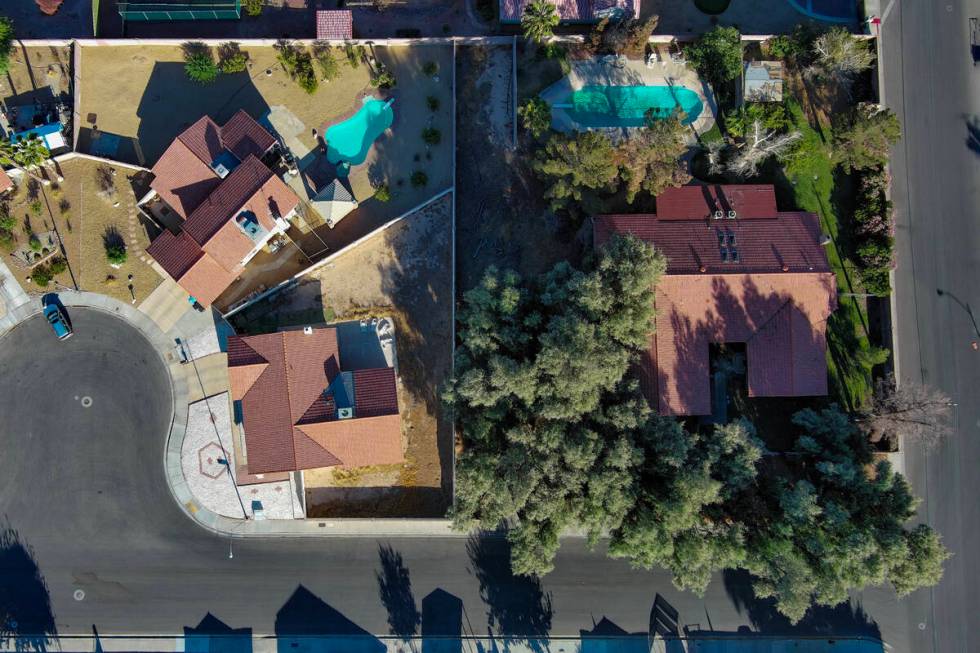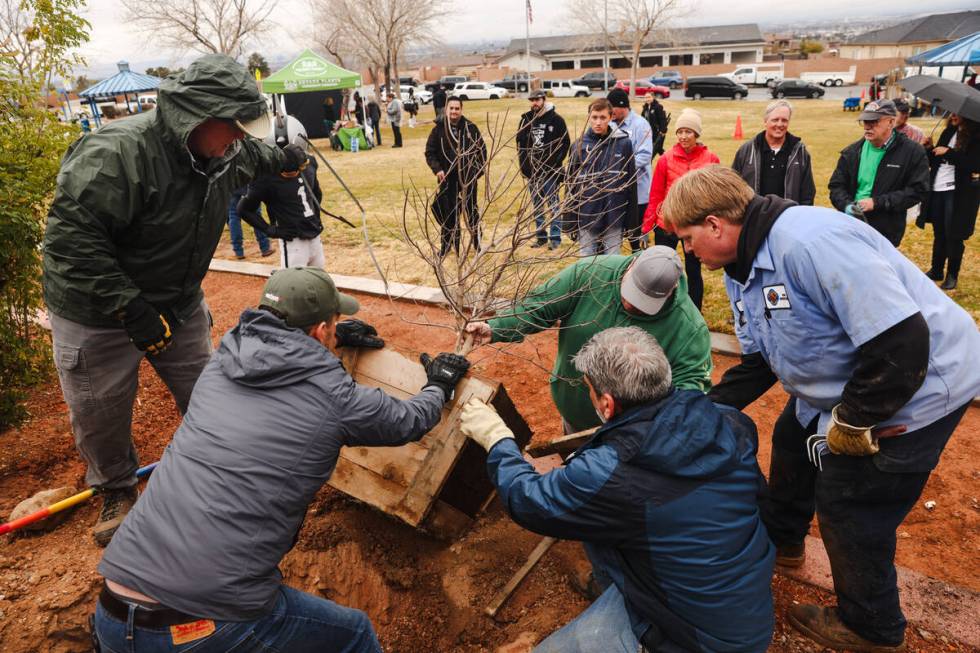Is Southern Nevada prepared for another deadly summer? Here’s its plan
It’s a bleak picture as climate change makes each Mojave Desert summer more lethal than the one before it.
Considered by most a transient place, Sin City sees more than 40 million tourists a year. Many come in the summer, with bodies that take two weeks to acclimate to such intense heat, according to experts. It’s home to children in classrooms with broken air conditioning, street performers hoping for tips while suffering in the sun, homeless people who have no escape from the wrath of the hotter days and nights.
As the number of heat-related deaths swells every year, efforts are increasing across the public and nonprofit sector to make Southern Nevada more habitable during periods of extreme heat.

Whether it’s more availability at community cooling centers or planting shady trees for generations to come, Las Vegas’ leaders are optimistic that they can meet the moment, laying the groundwork for a more effective heat response next summer.
“This isn’t a problem that’s going to go away,” said Ariel Choinard, director of the Southern Nevada Heat Resilience Lab at the Desert Research Institute. “Every summer will be the newest, hottest summer on record.”
And if the heat getting worse is a fact scientists see as inevitable, something that’s not irreversible is how well prepared cities are to adapt. Las Vegas’ heat response is still young and decentralized as academics, nonprofit leaders and elected officials work together to reach the most vulnerable groups.
“Temperatures are rising, and the more we run into that, the more people are going to come together to work on solutions,” Choinard said.
When cooling centers aren’t enough
Where many of these solutions will be hatched are at virtual meetings hosted by Choinard’s lab.
After intense heat events — such as when Las Vegas hit its all-time record of 120 degrees — and throughout the summer, Choinard invites about 90 representatives from local government, nonprofit organizations and more.
It’s a new effort, only two years in the making, which she said has led to fruitful brainstorming sessions.
“The trends are moving towards acceptance that heat, in itself, can be the primary hazard in a community, and that we need to mount an effective response,” said Jeff Quinn, manager of the Southern Nevada Health District’s Office of Public Health Preparedness. Quinn attends the heat lab’s meetings on behalf of the health district.
Much of Clark County’s response to heat-related death prevention has come in the form of cooling centers: libraries and community centers that open their doors to all and offer air conditioning. Activated once the National Weather Service issues an official heat advisory, government officials in many states have heralded cooling centers as a lifeline.
But researchers suspect they’re not as widely used as they could be — something Choinard and her team are hoping to study more in-depth with a survey next year.
“We’re all exposed to extreme heat, so that brings in cooling centers as the only official response that we have in our area to it,” said David Almanza, a Desert Research Institute postdoctoral researcher. “We wanted to know more about who was using these and why.”

Whether cooling centers are well attended is less important than them being an option in an emergency, Choinard said.
The lab has discussed working with Clark County and other partners to extend some cooling centers to 24 hours a day.
Still, cities’ response to heat should be more robust, said Dr. Ketan Patel, who works in the emergency department at University Medical Center. In many cases, the heat cannot be avoided, he said.
“You can’t spend an entire summer indoors or in air conditioning,” Patel said. “It’s just not a plausible solution.”
No heat officer in one of the fastest-warming cities
Something Nevada doesn’t have that its neighbors do is a full-time, permanent government employee who works on heat resilience.
Los Angeles appointed a chief heat officer in 2022 who works in the city’s Office of Climate Emergency Mobilization. Arizona chose a physician to be the country’s first statewide heat officer this year, and Phoenix became the first city to have an Office of Heat Response and Mitigation, established in 2021.
Even though the Silver State is home to what scientists say are the country’s two fastest-warming cities, no such office or permanent government employee works exclusively on heat response. Clark County’s sustainability office employs one rotating urban heat fellow.
Overall, efforts to work on heat are largely fractured among different entities, though Desert Research Institute’s heat lab is a new place for all of them to coordinate.
Jane Gilbert, who made history as the world’s first so-called “chief heat officer” in 2021 serving Miami-Dade County in Florida, said it’s not uncommon for a local government’s heat response to be new and collaborative.
Under Gilbert’s tenure, she created a heat action plan with 19 short-term goals, from installing cooler pavement to creating a county tree planting plan that her office unveiled this year. It’s incumbent on everyone who manages and designs cities, from politicians to architects, to better promote safety in a warming world, Gilbert said.
“It’s a mindset shift for everybody, no matter who they are,” she said, adding that there are several examples of cities creating innovative solutions to urban heat without a heat officer.

Trees an antidote to urban heat islands
The threat of heat illness can vary depending on where residents of Clark County live.
A contrast to the grassy meadows and now-dried up springs that once characterized the region, Las Vegas today is more known for sprawling pavement and short buildings than green spaces or tree cover.
Certain parts of the valley are considered “urban heat islands,” or areas where heat is felt more intensely than another that might benefit from the cooling effect of trees. A 2022 Regional Transit Commission study created a map of heat vulnerability, revealing where these heat islands lie. Most imperiled by heat are pockets of downtown Las Vegas, North Las Vegas and east Las Vegas.
Trees might be the remedy to extreme heat in many cases.
In fact, planting a tree in Las Vegas has the potential to cool off neighborhoods more than in any city that U.S. Geological Survey research ecologist Peter Ibsen studied over the past year. Even more so than grass.
Ibsen, the lead author of the study published in October, found that trees in Las Vegas had about a 45-degree cooling effect — a stark difference from other hot cities such as Miami where that cooling gain is closer to 35 degrees. The researchers placed temperature and humidity sensors on 80 to 100 trees, measuring a 60-meter zone around each of them.
“I’m a big fan of trees,” said Ibsen, who used to work as a landscaper. “Trees and land-cover conversions like parking lots to trees are an important part of the tool kit.”
That’s good news, especially considering the traction tree planting has gotten across Nevada. Nonprofit Impact NV has committed to planting 100,000 trees in Nevada over 10 years; UNLV’s Las Vegas Urban Forest Center will put in 3,000 trees in the next five years and train local aborists; and the city of Las Vegas has committed to installing 60,000 trees by 2050.
If some areas of Las Vegas could remove about 20 percent of its heat-trapping pavement and replace it with tree canopy, air temperature could decline by up to 4 or so degrees during heat waves, Ibsen said.

With heat, more and better messaging necessary
Slowly, extreme heat has pierced through the noise and become an issue that city and county managers can no longer ignore.
Kristie Ebi, a University of Washington professor who has studied the intersection of public health and climate change for decades, said it’s difficult to communicate with those who suffer the most in the heat, whether that’s the elderly, the unhoused or people suffering with addiction.
To Ebi, heat should be embedded into conversations from sources people trust. For instance, faith organizations can do their part in telling people about resources, and pharmacists should opt to tell people when prescriptions make them more likely to suffer from heat illness.
“The people who need the warnings aren’t really heeding them,” she said.
Choinard, of the Desert Research Institute’s heat lab, said she’s well aware that there’s more work to be done. Coordinating an effective response to extreme heat that Las Vegas deserves is a long game that involves dozens of players, she said.
“There are so many relationships to be built and developed over time. We have to move at the speed of trust,” Choinard said. “There’s no one weird trick to fix extreme heat. It takes time, and we’ll keep moving this work forward.”
Contact Alan Halaly at ahalaly@reviewjournal.com. Follow @AlanHalaly on X. Staff writer Katie Futterman contributed to this report.












